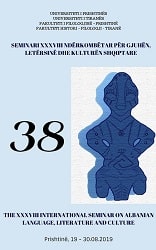Përshkrimi i strukturave gjuhësore të gjinizuara si sfidë për reflektimin e ndërtimit të identiteteve gjinore në gjuhën shqipe
Description of Gendered Linguistic Structures as a Challenge to Reflect the Construction of Gender Identities in the Albanian Language
Author(s): Delina BinajSubject(s): Gender Studies, Syntax, Sociolinguistics, Philology
Published by: Univeristeti i Prishtinës, Fakulteti i Filologjisë
Keywords: grammatical gender; gender identity; gender affiliation; constructivism; androcentric masculine;
Summary/Abstract: Grammatical gender is regarded as a central category in the structure of the Albanian nominal system. According to Albanian grammars, nouns in Albanian belong to one of two grammatical gender classes: feminine and masculine. Albanian also has a neuter gender, however this is no more than a relic. As a language with grammatical gender, elements within Albanian noun phrases (e.g. adjectives, pronouns etc.), but also outside noun phrases (e.g. anaphoric pronouns) require an agreement with the grammatical gender of the noun. In consequence, the Albanian language is characterized by linguistic structures, which are to a large extent shaped by grammatical gender. This paper will discuss the gendered linguistic structures in contemporary Albanian while putting the focus on personal nouns. The way how gendered linguistic structures are described in standardizing grammars, legitimizes the use of androcentric masculine as a linguistic norm for naming practices of people by making women invisible in language. The analyses, which will be presented, are based on a constructivist approach. It focuses on the language use of individuals analysing them within the specificity of the context. Rather than interpreting language as mirror of the social reality, in a constructivist perspective linguistic forms are seen as crucial elements of shaping social realities. This enables us therefore to perceive gendered linguistic structures not as predetermined and static, but as in social, cultural contexts and hence discursively constructed. This contribution will provide findings based on the examination of a variety of materials, including grammars as well as language use in the media and in public.
Journal: Seminari Ndërkombëtar për Gjuhën, Letërsinë dhe Kulturën Shqiptare
- Issue Year: 2019
- Issue No: 38.1
- Page Range: 178-192
- Page Count: 15
- Language: Albanian

